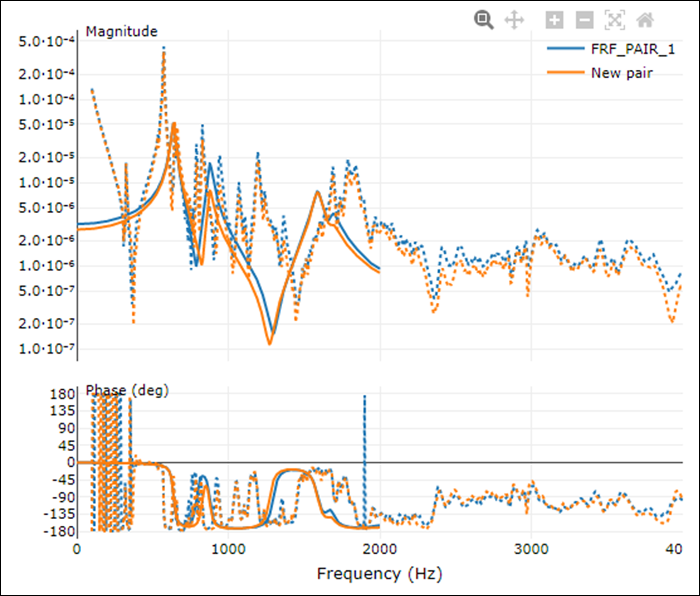The FRF Comparison Plotter allows you to display and compare computational and experimental FRFs or two computational FRFs previously defined and computed in the FRF Worksheet. The FRF Comparison Plotter is opened using the button.
The FRF Comparison Plotter is divided into two parts:
- FRF Comparison Plot
A dynamic plot that allows hovering, zooming and panning operations. The FRFs are always displayed in Magnitude and Phase format. The FRF pairs are displayed when a completely defined FRF pair is selected.

- FRF Comparison Worksheet
A worksheet with three right-click actions:

- Show/Hide
If the DOF pair is selected/cleared, it is displayed/hidden in the FRF Comparison Plot. This action supports multi-selection (if several rows are selected, the / action is applied to all those rows).
- Add
Add a new FRF pair to the table. This action does not support multi-selection.
- Delete
Delete all the selected rows from the table. This action supports multi-selection (if several rows are selected, the action removes all those rows).
Each column in the worksheet can be edited in a different way:
- FRF1
This column defines the first FRF in the FRF Pair. It can be modified through a dropdown menu that is populated with all the selected FRFs from the computational model (FRFs from the first FRF DOF Pair Table in the FRF Worksheet).
- FRF2
This column defines the second FRF in the FRF Pair. It can be modified through a dropdown menu that is populated with all the selected FRFs from both the computational and UNV models (FRFs from the first and second FRF DOF Pair Tables in the FRF Worksheet).
- Name
The contents of this column are modified by entering text, which changes the predefined name.
In addition, there are two buttons above the Worksheet with different functionality:
- Pair UNV FRFs
This button is only available when UNV data is available. In this case, clicking the button triggers a 3-step algorithm:
The nodes that define the selected UNV FRFs in the second DOF Pair Table are matched with the computational nodes.
Computational FRFs are defined using the matched nodes and the same DOFs and coordinate systems. These computational FRFs are the computational counterparts of the selected experimental FRFs.
FRF pairs are defined between each experimental and computational FRF counterpart.
- Export to CSV
Exports the contents of the FRF Comparison Worksheet to a CSV file.


